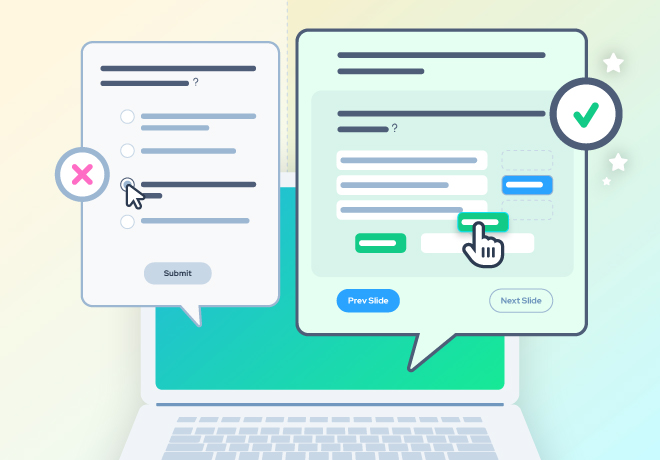
How to engage your learners with the power of storytelling

Related articles
Get valuable eLearning insights to your inbox.
Listen to Neovation’s Demystifying eLearning podcast generated with NotebookLM!
Listen to our podcast on your favorite platform!
The lure of a good story is something we never outgrow. Stories inspire and engage listeners, draw in readers, and entice people to stay up late so they can find out what happens to their favorite characters.
Instructional content too often has the opposite effect: If it's not literally putting people to sleep, it might lead to glazed eyes and diminished attention.
Revising dull, text-heavy slides or screens of eLearning content to adopt a narrative style and framework is an important way to enliven training content and hold learners’ attention, whether those learners are in grade school or are adult professionals.
That’s why learning designers looking to improve learner experience and engagement with content are increasingly tapping into the power of storytelling.
The science of story

Stories activate many areas of learners’ brains, engaging them in ways that bare facts cannot. Listeners or readers use sensory and motor processing centers to respond to a story, leading to a fuller experience of the information and its context. “The more a speaker conveys information in story form, the closer the listener’s experience and understanding will be to what the speaker actually intended,” they wrote.
The experience goes even further: “When we’re listening to a good story — rich in detail, full of metaphor, expressive of character — we tend to imagine ourselves in the same situation” — whether it’s a ghost story around the campfire sending chills down our spines or an impactful business story that relates to our day-to-day work experiences.
Stories can improve training satisfaction
Reworking instructional content into a narrative format can lead to higher training satisfaction, Armstrong and Landers found (2018), than when the same content is presented as bullet lists on web-based slide shows. Their study looked at narrative as just one of many elements that can improve learners’ motivation to spend time with (and learn from) training content.
Armstrong and Landers found that “training satisfaction was more positive for gamified narrative training content than for the original content despite meeting fully identical learning objectives.”
Narrative format can improve motivation
That’s not surprising. Storytelling motivates by providing deeper meaning and context to content that may be important but might not be very engaging when presented simply as facts.
Sailer et al. agree that integrating a narrative context into learning content can motivate: “Narrative contexts can be oriented towards real, non-game contexts or act as analogies of real-world settings. The latter can enrich boring, barely stimulating contexts, and, consequently, inspire and motivate players — particularly if the story is in line with their personal interests.”
Storytelling is often part of a game or gamified learning context, but it does not have to be. Sailer et al. go on to explain that narrative can provide context for characters and activities that enrich content and give training meaning beyond accumulating points, moving through a series of challenges, or completing a set of slides or videos.
Stories can help learning stick
Stories also add “emotional glue” that connects learners with the message and content, according to eLearning coach Connie Malamed, making content and information more memorable. When learners absorb and remember a story — and the training content it relays — they are more likely to share that information with others, reinforcing their own memory as well as passing on the information to colleagues.
Whether your learning goal requires creating a feeling of connection, an emotional response, inspiring learners, or simply exchanging ideas and fostering growth, story is a proven vehicle for achieving these goals.
Learning Hub: free resources for eLearning
The Neovation Learning Hub contains many free resources and articles that can help you improve eLearning outcomes at your organization. Continue learning about Custom eLearning Development topics, read articles on Instructional Design, or find new eLearning tools to help you with your eLearning initiatives.

An experienced writer, editor, tech writer, and blogger, Pam helps you make sense of learning science and eLearning technology. She provides information you can use to drive improvements in your training effectiveness and ROI.
Become part of our L&D community
We publish a new learning hub article — full of useful, practical topics — weekly.
Not sure where where you want to start? Jump into one of our recently published articles and see where it takes you!








-svg.svg)
-svg.svg)
-svg.svg)
-svg.svg)